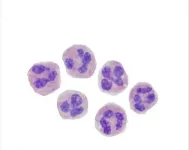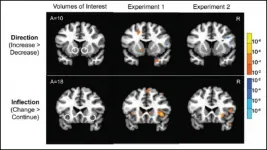INFORMATION:
This research was supported, in part, by the Alfred Sloan Foundation and the National Cancer Institute.
Written by Jennifer Chu, MIT News Office
Paper: "Nonlinear elasticity of biological basement membrane revealed by rapid inflation and deflation"
https://www.pnas.org/content/118/11/e2022422118
Membrane around tumors may be key to preventing metastasis
Tough as plastic wrap but elastic like a balloon, the lining could be a target for therapies to limit cancer cells from spreading.
2021-03-08
(Press-News.org) For cancer cells to metastasize, they must first break free of a tumor's own defenses. Most tumors are sheathed in a protective "basement" membrane -- a thin, pliable film that holds cancer cells in place as they grow and divide. Before spreading to other parts of the body, the cells must breach the basement membrane, a material that itself has been tricky for scientists to characterize.
Now MIT engineers have probed the basement membrane of breast cancer tumors and found that the seemingly delicate coating is as tough as plastic wrap, yet surprisingly elastic like a party balloon, able to inflate to twice its original size.
But while a balloon becomes much easier to blow up after some initial effort, the team found that a basement membrane becomes stiffer as it expands.
This stiff yet elastic quality may help basement membranes control how tumors grow. The fact that the membranes appear to stiffen as they expand suggests that they may restrain a tumor's growth and potential to spread, or metastasize, at least to a certain extent.
The findings, published this week in the Proceedings of the National Academy of Sciences, may open a new route toward preventing tumor metastasis, which is the most common cause of cancer-related deaths.
"Now we can think of ways to add new materials or drugs to further enhance this stiffening effect, and increase the toughness of the membrane to prevent cancer cells from breaking through," says Ming Guo, a lead author of the study and associate professor of mechanical engineering at MIT.
Guo's co-authors include first author Hui Li of Beijing Normal University, Yue Zheng and Shengqiang Cai of the University of California at Santa Diego, and MIT postdoc Yu Long Han.
Blowing up
The basement membrane envelopes not only cancerous growths but also healthy tissues and organs. The film -- a fraction of the thickness of a human hair -- serves as a physical support that holds tissues and organs in place and helps to shape their geometry, while also keeping them separate and distinct.
Guo's group specializes in the study of cell mechanics, with a focus on the behavior of cancer cells and the processes that drive tumors to metastasize. The researchers had been investigating how these cells interact with their surroundings as they migrate through the body.
"A critical question we realized hasn't gotten enough attention is, what about the membrane surrounding tumors?" Guo says. "To get out, cells have to break this layer. What is this layer in terms of material properties? Is it something cells have to work really hard to break? That's what motivated us to look into the basement membrane."
To measure the membrane's properties, scientists have employed atomic force microscopy (AFM), using a tiny mechanical probe to gently push on the membrane's surface. The force required to deform the surface can give researchers an idea of a material's resistance or elasticity. But, as the basement membrane is exceedingly thin and tricky to separate from underlying tissue, Guo says it's difficult to know from AFM measurements what the resistance of the membrane is, apart from the tissue underneath.
Instead, the team used a simple technique, similar to blowing up a balloon, to isolate the membrane and measure its elasticity. They first cultured human breast cancer cells, which naturally secrete proteins to form a membrane around groups of cells known as tumor spheroids. They grew several spheroids of various sizes and inserted a glass microneedle into each tumor. They injected the tumors with fluid at a controlled pressure, causing the membranes to detach from the cells and inflate like a balloon.
The researchers applied various constant pressures to inflate the membranes until they reached a steady state, or could expand no more, then turned the pressure off.
"It's a very simple experiment that can tell you a few things," Guo says. "One is, when you inject pressure to swell this balloon, it gets much bigger than its original size. And as soon as you release the pressure, it gradually shrinks back, which is a classical behavior of an elastic material, similar to a rubber balloon."
Elastic snap
As they inflated each spheroid, the researchers observed that, while a basement membrane's ability to inflate and deflate showed that it was generally elastic like a balloon, the more specific details of this behavior were surprisingly different.
To blow up a latex balloon typically requires a good amount of effort and pressure to start up. Once it gets going and starts to inflate a bit, the balloon suddenly becomes much easier to blow up.
"Typically, once the radius of a balloon increases by about 38 percent, you don't need to blow any harder -- just maintain pressure and the balloon will expand dramatically," Guo says.
This phenomenon, known as snap-through instability, is seen in balloons made of materials that are linearly elastic, meaning their inherent elasticity, or stiffness, does not change as they deform or inflate.
But based on their measurements, the researchers found that the basement membrane instead became stiffer, or more resistant as it inflated, indicating that the material is nonlinearly elastic, and able to change its stiffness as it deforms.
"If snap-through instability were to occur, a tumor would become a disaster -- it would just explode," Guo says. "In this case, it doesn't. That indicates to me that the basement membrane provides a control on growth."
The team plans to measure the membrane's properties at different stages of cancer development, as well as its behavior around healthy tissues and organs. They are also exploring ways to modify the membrane's elasticity to see whether making it stiffer will prevent cancer cells from breaking through.
"We are actively following up on how to modify the mechanics of these membranes, and apply perturbations on breast cancer models, to see if we can delay their invasion or metastasis," Guo says. "This is an analogy to making a stiffer balloon, which we plan to try."
ELSE PRESS RELEASES FROM THIS DATE:
A plant's place in history can predict susceptibility to pathogens
2021-03-08
Found around the world, powdery mildew is a fungal disease especially harmful to plants within the sunflower family. Like most invasive pathogens, powdery mildew is understudied and learning how it affects hosts can help growers make more informed decisions and protect their crops.
Scientists at the University of Washington and the University of Central Florida inoculated 126 species of plants in the sunflower family with powdery mildew, growing 500 plants from seeds that were collected from the wild and provided from the USDA germplasm network. Through this ...
Are higher obesity rates in minority groups a product of systemic racism?
2021-03-08
BOSTON - The higher rates of obesity in Black, Indigenous and People of Color (BIPOC) compared with other groups in the United States can be attributed in large part to systemic racism, according to a new perspective article published in the Journal of Internal Medicine. The authors offer a 10-point strategy to study and solve the public health issues responsible for this disparity.
"First, it is important to recognize that the interplay of obesity and racism is real. Once persons recognize this, they can begin to appropriately address and treat obesity in BIPOC communities," says co-author Fatima Cody ...
Hypertension disorders of pregnancy increase risk of premature maternal mortality
2021-03-08
Women who experienced hypertensive disorders of pregnancy (HDPs) but did not develop chronic hypertension have a greater risk of premature mortality, specifically cardiovascular disease (CVD)-related deaths, according to a study published in the Journal of the American College of Cardiology (JACC). A separate JACC study examined the cardiovascular health risks associated with pregnancy in obese women with heart disease.
HDPs, which occur in approximately 10% of all pregnancies worldwide, are among the most common health issues during pregnancy. There are four types of HDPs: chronic hypertension, gestational hypertension (GHTN), preeclampsia and ...
Why odors trigger powerful memories
2021-03-08
Other senses re-routed during evolution, but not sense of smell
Loss of smell linked to depression and poor quality of life
Smell research can help treatments for loss in COVID-19
CHICAGO ---Odors evoke powerful memories, an experience enshrined in literature by Marcel Proust and his beloved madeleine.
A new Northwestern Medicine paper is the first to identify a neural basis for how the brain enables odors to so powerfully elicit those memories. The paper shows unique connectivity between the hippocampus--the seat of memory in the brain--and olfactory areas in humans.
This new research suggests a neurobiological basis for privileged access by olfaction to memory areas in the brain. The study compares connections between primary sensory areas--including ...
New technique brings the study of molecular configuration into the microscopic domain
2021-03-08
Researchers have developed a spectroscopic microscope to enable optical measurements of molecular conformations and orientations in biological samples. The novel measurement technique allows researchers to image biological samples at the microscopic level more quickly and accurately.
The new instrument is based on the discrete frequency infrared spectroscopic imaging technique developed by researchers at the Beckman Institute for Advanced Science and Technology at the University of Illinois Urbana-Champaign.
"This project is about bringing the study ...
Speeding treatment for urinary tract infections in children
2021-03-08
DALLAS - March 8, 2021 - A study led by UT Southwestern and Children's Health researchers defines parameters for the number of white blood cells that must be present in children's urine at different concentrations to suggest a urinary tract infection (UTI). The findings, published recently in Pediatrics, could help speed treatment of this common condition and prevent potentially lifelong complications.
UTIs account for up to 7 percent of fevers in children up to 24 months old and are a common driver of hospital emergency room visits. However, says study leader Shahid Nadeem, M.D., assistant professor of pediatrics at UTSW as well as an emergency department physician and pediatric nephrologist at Children's Medical Center Dallas, these bacterial infections ...
Financial pollution in the US health system
2021-03-08
Boston, MA - Financial pollution arises when exorbitant or unnecessary healthcare spending depletes resources needed for the wellbeing of the population. This is the subject of a JAMA Health Forum Insight co-authored by researchers in the Department of Population Medicine at Harvard Pilgrim Health Care Institute and Harvard Medical School. The Insight was published in the March 8, 2021 issue of JAMA Health Forum.
The authors lay out the rationale for "financial pollution" as a metaphor to express the urgency of addressing wasteful health care spending and to guide innovative policymaking. Akin to environmental pollution, financial ...
Understanding the resilience of barrier islands and coastal dunes after storms
2021-03-08
When a coastline undergoes massive erosion, like a hurricane flattening a beach and its nearby environments, it has to rebuild itself - relying on the resilience of its natural coastal structures to begin piecing itself back together in a way that will allow it to survive the next large phenomena that comes its way.
Drs. Orencio Duran Vinent, assistant professor, and Ignacio Rodriguez-Iturbe, Distinguished University Professor and Wofford Cain Chair I Professor, in the Department of Ocean Engineering at Texas A&M University, are investigating the resilience of barrier ...
A better way to measure acceleration
2021-03-08
You're going at the speed limit down a two-lane road when a car barrels out of a driveway on your right. You slam on the brakes, and within a fraction of a second of the impact an airbag inflates, saving you from serious injury or even death.
The airbag deploys thanks to an accelerometer -- a sensor that detects sudden changes in velocity. Accelerometers keep rockets and airplanes on the correct flight path, provide navigation for self-driving cars, and rotate images so that they stay right-side up on cellphones and tablets, among other essential tasks.
Addressing the increasing ...
Brain activity foreshadows changes in stock prices
2021-03-08
Forecasting changes in stock prices may be possible with the help of brain activity in regions associated with how people feel before making investment choices. Scientists could accurately forecast market price changes based on the average brain activity among a group but failed when using only prior stock trends or people's investment choices, according to new research published in JNeurosci.
Scientists have used the average brain activity among a group to predict which videos will go viral and which crowdfunding campaigns will receive funding. In a new study, Stallen et al. investigated if this relationship extends to a more ...
LAST 30 PRESS RELEASES:
Tracing the quick synthesis of an industrially important catalyst
New software sheds light on cancer’s hidden genetic networks
UT Health San Antonio awarded $3 million in CPRIT grants to bolster cancer research and prevention efforts in South Texas
Third symposium spotlights global challenge of new contaminants in China’s fight against pollution
From straw to soil harmony: International team reveals how biochar supercharges carbon-smart farming
Myeloma: How AI is redrawing the map of cancer care
Manhattan E. Charurat, Ph.D., MHS invested as the Homer and Martha Gudelsky Distinguished Professor in Medicine at the University of Maryland School of Medicine
Insilico Medicine’s Pharma.AI Q4 Winter Launch Recap: Revolutionizing drug discovery with cutting-edge AI innovations, accelerating the path to pharmaceutical superintelligence
Nanoplastics have diet-dependent impacts on digestive system health
Brain neuron death occurs throughout life and increases with age, a natural human protein drug may halt neuron death in Alzheimer’s disease
SPIE and CLP announce the recipients of the 2025 Advanced Photonics Young Innovator Award
Lessons from the Caldor Fire’s Christmas Valley ‘Miracle’
Ant societies rose by trading individual protection for collective power
Research reveals how ancient viral DNA shapes early embryonic development
A molecular gatekeeper that controls protein synthesis
New ‘cloaking device’ concept to shield sensitive tech from magnetic fields
Researchers show impact of mountain building and climate change on alpine biodiversity
Study models the transition from Neanderthals to modern humans in Europe
University of Phoenix College of Doctoral Studies releases white paper on AI-driven skilling to reduce burnout and restore worker autonomy
AIs fail at the game of visual “telephone”
The levers for a sustainable food system
Potential changes in US homelessness by ending federal support for housing first programs
Vulnerability of large language models to prompt injection when providing medical advice
Researchers develop new system for high-energy-density, long-life, multi-electron transfer bromine-based flow batteries
Ending federal support for housing first programs could increase U.S. homelessness by 5% in one year, new JAMA study finds
New research uncovers molecular ‘safety switch’ shielding cancers from immune attack
Bacteria resisting viral infection can still sink carbon to ocean floor
Younger biological age may increase depression risk in older women during COVID-19
Bharat Innovates 2026 National Basecamp Showcases India’s Most Promising Deep-Tech Ventures
Here’s what determines whether your income level rises or falls
[Press-News.org] Membrane around tumors may be key to preventing metastasisTough as plastic wrap but elastic like a balloon, the lining could be a target for therapies to limit cancer cells from spreading.





